wheel size CHEVROLET SILVERADO 2011 2.G Owners Manual
[x] Cancel search | Manufacturer: CHEVROLET, Model Year: 2011, Model line: SILVERADO, Model: CHEVROLET SILVERADO 2011 2.GPages: 588, PDF Size: 7.99 MB
Page 117 of 588
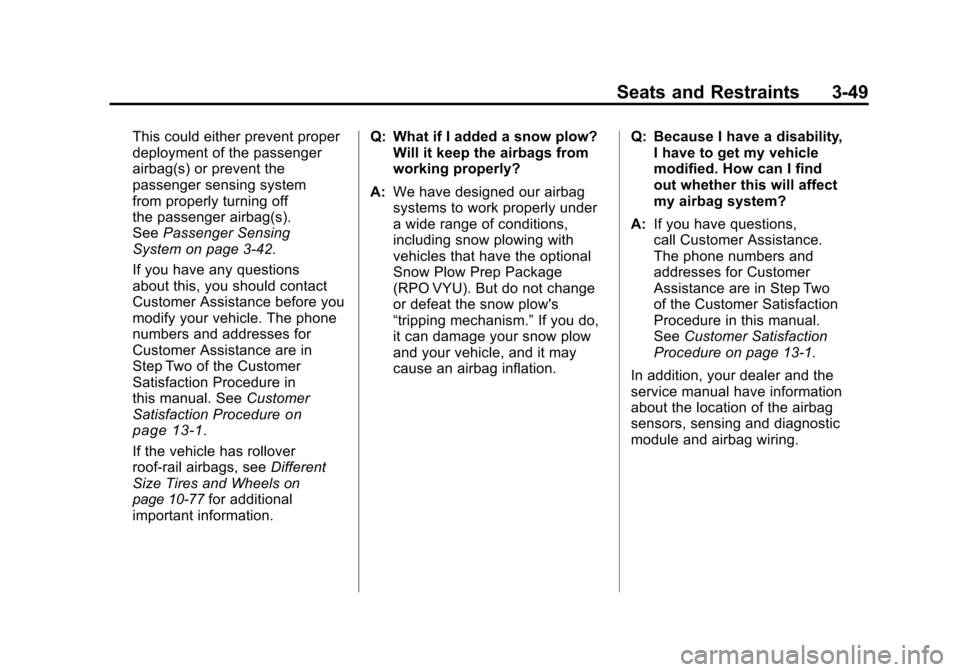
Black plate (49,1)Chevrolet Silverado Owner Manual - 2011
Seats and Restraints 3-49
This could either prevent proper
deployment of the passenger
airbag(s) or prevent the
passenger sensing system
from properly turning off
the passenger airbag(s).
SeePassenger Sensing
System on page 3‑42.
If you have any questions
about this, you should contact
Customer Assistance before you
modify your vehicle. The phone
numbers and addresses for
Customer Assistance are in
Step Two of the Customer
Satisfaction Procedure in
this manual. See Customer
Satisfaction Procedure
on
page 13‑1.
If the vehicle has rollover
roof-rail airbags, see Different
Size Tires and Wheels
on
page 10‑77for additional
important information. Q: What if I added a snow plow?
Will it keep the airbags from
working properly?
A: We have designed our airbag
systems to work properly under
a wide range of conditions,
including snow plowing with
vehicles that have the optional
Snow Plow Prep Package
(RPO VYU). But do not change
or defeat the snow plow's
“tripping mechanism.” If you do,
it can damage your snow plow
and your vehicle, and it may
cause an airbag inflation. Q: Because I have a disability,
I have to get my vehicle
modified. How can I find
out whether this will affect
my airbag system?
A: If you have questions,
call Customer Assistance.
The phone numbers and
addresses for Customer
Assistance are in Step Two
of the Customer Satisfaction
Procedure in this manual.
See Customer Satisfaction
Procedure on page 13‑1.
In addition, your dealer and the
service manual have information
about the location of the airbag
sensors, sensing and diagnostic
module and airbag wiring.
Page 424 of 588
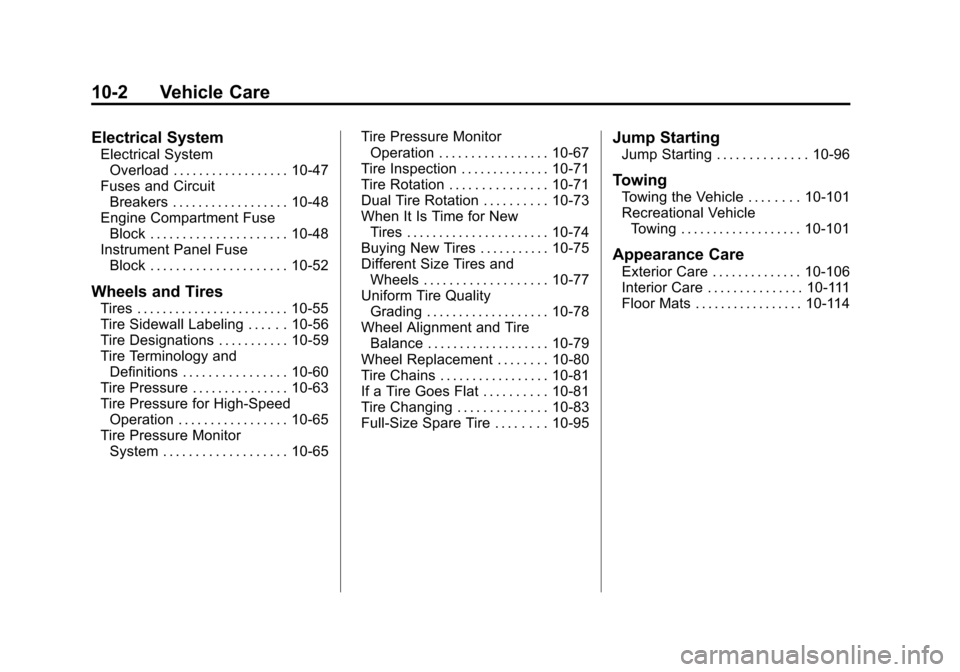
Black plate (2,1)Chevrolet Silverado Owner Manual - 2011
10-2 Vehicle Care
Electrical System
Electrical SystemOverload . . . . . . . . . . . . . . . . . . 10-47
Fuses and Circuit Breakers . . . . . . . . . . . . . . . . . . 10-48
Engine Compartment Fuse
Block . . . . . . . . . . . . . . . . . . . . . 10-48
Instrument Panel Fuse Block . . . . . . . . . . . . . . . . . . . . . 10-52
Wheels and Tires
Tires . . . . . . . . . . . . . . . . . . . . . . . . 10-55
Tire Sidewall Labeling . . . . . . 10-56
Tire Designations . . . . . . . . . . . 10-59
Tire Terminology andDefinitions . . . . . . . . . . . . . . . . 10-60
Tire Pressure . . . . . . . . . . . . . . . 10-63
Tire Pressure for High-Speed Operation . . . . . . . . . . . . . . . . . 10-65
Tire Pressure Monitor System . . . . . . . . . . . . . . . . . . . 10-65 Tire Pressure Monitor
Operation . . . . . . . . . . . . . . . . . 10-67
Tire Inspection . . . . . . . . . . . . . . 10-71
Tire Rotation . . . . . . . . . . . . . . . 10-71
Dual Tire Rotation . . . . . . . . . . 10-73
When It Is Time for New Tires . . . . . . . . . . . . . . . . . . . . . . 10-74
Buying New Tires . . . . . . . . . . . 10-75
Different Size Tires and Wheels . . . . . . . . . . . . . . . . . . . 10-77
Uniform Tire Quality Grading . . . . . . . . . . . . . . . . . . . 10-78
Wheel Alignment and Tire Balance . . . . . . . . . . . . . . . . . . . 10-79
Wheel Replacement . . . . . . . . 10-80
Tire Chains . . . . . . . . . . . . . . . . . 10-81
If a Tire Goes Flat . . . . . . . . . . 10-81
Tire Changing . . . . . . . . . . . . . . 10-83
Full-Size Spare Tire . . . . . . . . 10-95
Jump Starting
Jump Starting . . . . . . . . . . . . . . 10-96
Towing
Towing the Vehicle . . . . . . . . 10-101
Recreational Vehicle Towing . . . . . . . . . . . . . . . . . . . 10-101
Appearance Care
Exterior Care . . . . . . . . . . . . . . 10-106
Interior Care . . . . . . . . . . . . . . . 10-111
Floor Mats . . . . . . . . . . . . . . . . . 10-114
Page 478 of 588
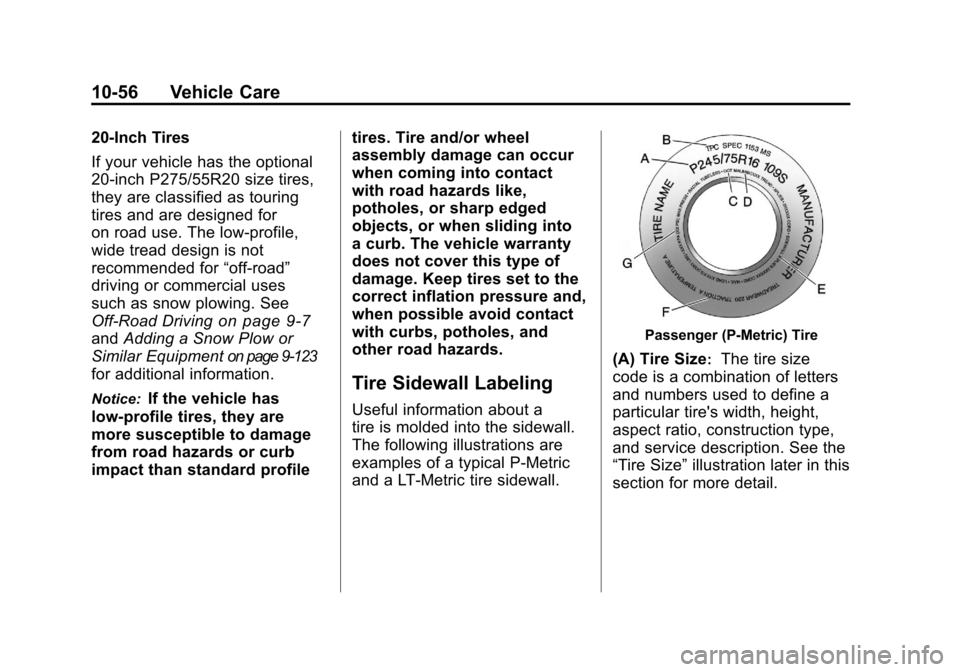
Black plate (56,1)Chevrolet Silverado Owner Manual - 2011
10-56 Vehicle Care
20‐Inch Tires
If your vehicle has the optional
20‐inch P275/55R20 size tires,
they are classified as touring
tires and are designed for
on road use. The low‐profile,
wide tread design is not
recommended for“off‐road”
driving or commercial uses
such as snow plowing. See
Off-Road Driving
on page 9‑7
and Adding a Snow Plow or
Similar Equipment
on page 9‑123
for additional information.
Notice:If the vehicle has
low‐profile tires, they are
more susceptible to damage
from road hazards or curb
impact than standard profile tires. Tire and/or wheel
assembly damage can occur
when coming into contact
with road hazards like,
potholes, or sharp edged
objects, or when sliding into
a curb. The vehicle warranty
does not cover this type of
damage. Keep tires set to the
correct inflation pressure and,
when possible avoid contact
with curbs, potholes, and
other road hazards.Tire Sidewall Labeling
Useful information about a
tire is molded into the sidewall.
The following illustrations are
examples of a typical P‐Metric
and a LT‐Metric tire sidewall.
Passenger (P‐Metric) Tire
(A) Tire Size:The tire size
code is a combination of letters
and numbers used to define a
particular tire's width, height,
aspect ratio, construction type,
and service description. See the
“Tire Size” illustration later in this
section for more detail.
Page 481 of 588
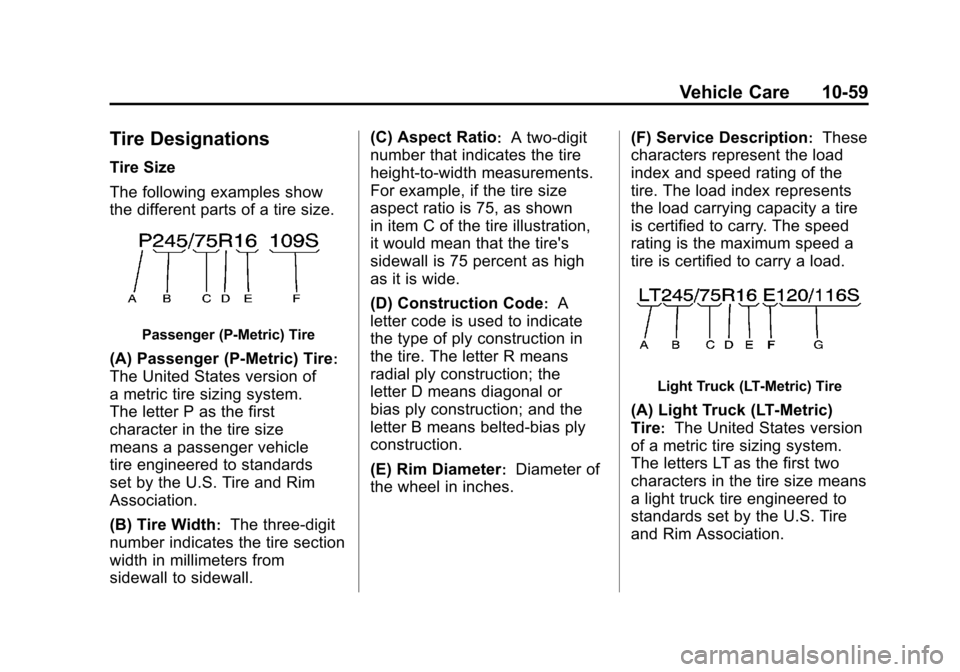
Black plate (59,1)Chevrolet Silverado Owner Manual - 2011
Vehicle Care 10-59
Tire Designations
Tire Size
The following examples show
the different parts of a tire size.
Passenger (P‐Metric) Tire
(A) Passenger (P‐Metric) Tire:
The United States version of
a metric tire sizing system.
The letter P as the first
character in the tire size
means a passenger vehicle
tire engineered to standards
set by the U.S. Tire and Rim
Association.
(B) Tire Width
:The three‐digit
number indicates the tire section
width in millimeters from
sidewall to sidewall. (C) Aspect Ratio
:A two‐digit
number that indicates the tire
height‐to‐width measurements.
For example, if the tire size
aspect ratio is 75, as shown
in item C of the tire illustration,
it would mean that the tire's
sidewall is 75 percent as high
as it is wide.
(D) Construction Code
:A
letter code is used to indicate
the type of ply construction in
the tire. The letter R means
radial ply construction; the
letter D means diagonal or
bias ply construction; and the
letter B means belted‐bias ply
construction.
(E) Rim Diameter
:Diameter of
the wheel in inches. (F) Service Description
:These
characters represent the load
index and speed rating of the
tire. The load index represents
the load carrying capacity a tire
is certified to carry. The speed
rating is the maximum speed a
tire is certified to carry a load.
Light Truck (LT‐Metric) Tire
(A) Light Truck (LT‐Metric)
Tire
:The United States version
of a metric tire sizing system.
The letters LT as the first two
characters in the tire size means
a light truck tire engineered to
standards set by the U.S. Tire
and Rim Association.
Page 482 of 588
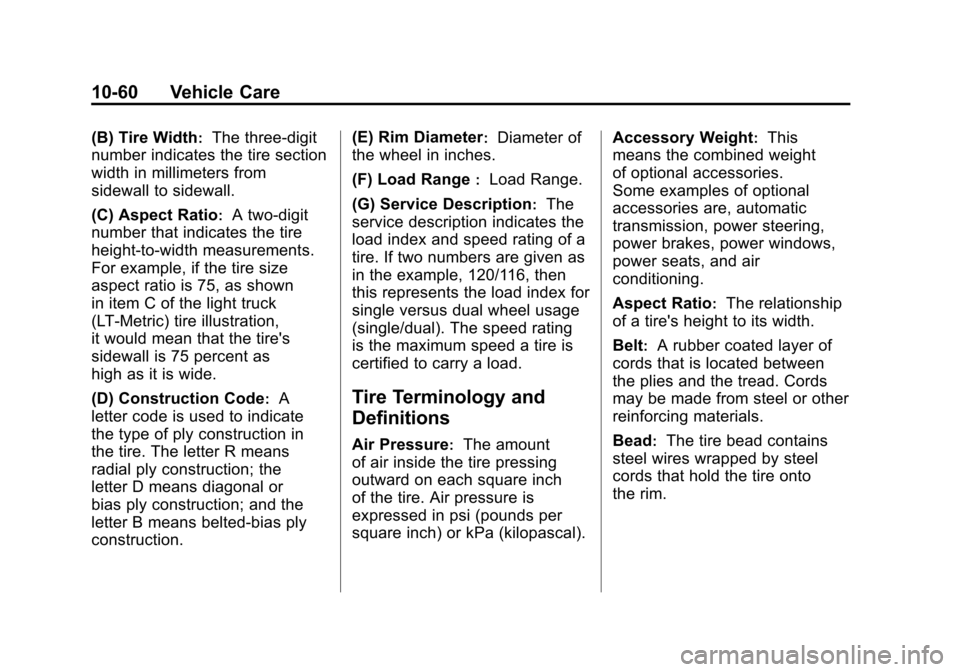
Black plate (60,1)Chevrolet Silverado Owner Manual - 2011
10-60 Vehicle Care
(B) Tire Width:The three‐digit
number indicates the tire section
width in millimeters from
sidewall to sidewall.
(C) Aspect Ratio
:A two‐digit
number that indicates the tire
height‐to‐width measurements.
For example, if the tire size
aspect ratio is 75, as shown
in item C of the light truck
(LT‐Metric) tire illustration,
it would mean that the tire's
sidewall is 75 percent as
high as it is wide.
(D) Construction Code
:A
letter code is used to indicate
the type of ply construction in
the tire. The letter R means
radial ply construction; the
letter D means diagonal or
bias ply construction; and the
letter B means belted‐bias ply
construction. (E) Rim Diameter
:Diameter of
the wheel in inches.
(F) Load Range
:Load Range.
(G) Service Description
:The
service description indicates the
load index and speed rating of a
tire. If two numbers are given as
in the example, 120/116, then
this represents the load index for
single versus dual wheel usage
(single/dual). The speed rating
is the maximum speed a tire is
certified to carry a load.
Tire Terminology and
Definitions
Air Pressure:The amount
of air inside the tire pressing
outward on each square inch
of the tire. Air pressure is
expressed in psi (pounds per
square inch) or kPa (kilopascal). Accessory Weight
:This
means the combined weight
of optional accessories.
Some examples of optional
accessories are, automatic
transmission, power steering,
power brakes, power windows,
power seats, and air
conditioning.
Aspect Ratio
:The relationship
of a tire's height to its width.
Belt
:A rubber coated layer of
cords that is located between
the plies and the tread. Cords
may be made from steel or other
reinforcing materials.
Bead
:The tire bead contains
steel wires wrapped by steel
cords that hold the tire onto
the rim.
Page 489 of 588
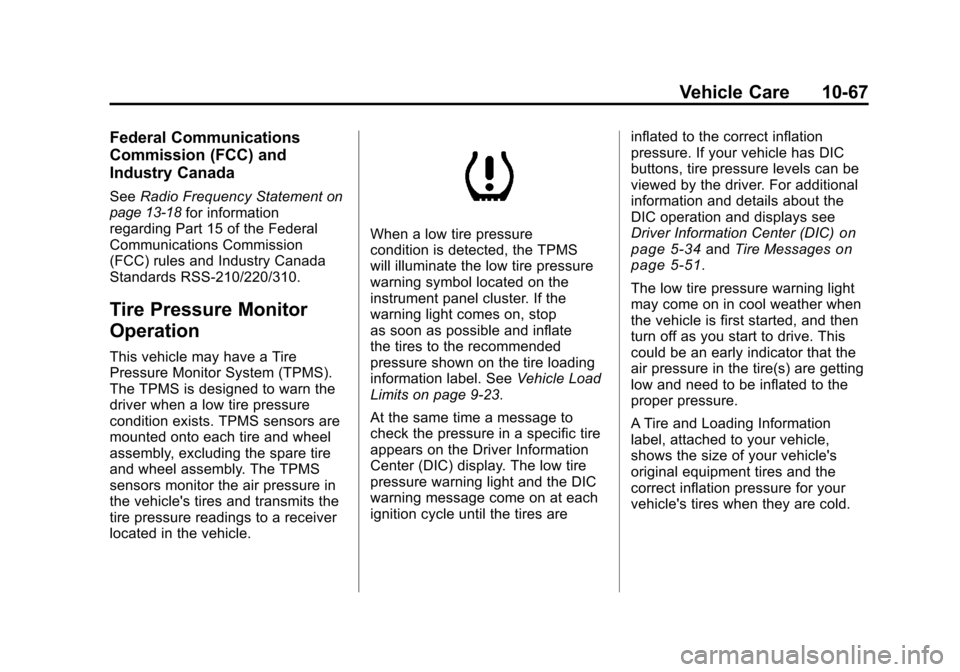
Black plate (67,1)Chevrolet Silverado Owner Manual - 2011
Vehicle Care 10-67
Federal Communications
Commission (FCC) and
Industry Canada
SeeRadio Frequency Statementon
page 13‑18for information
regarding Part 15 of the Federal
Communications Commission
(FCC) rules and Industry Canada
Standards RSS-210/220/310.
Tire Pressure Monitor
Operation
This vehicle may have a Tire
Pressure Monitor System (TPMS).
The TPMS is designed to warn the
driver when a low tire pressure
condition exists. TPMS sensors are
mounted onto each tire and wheel
assembly, excluding the spare tire
and wheel assembly. The TPMS
sensors monitor the air pressure in
the vehicle's tires and transmits the
tire pressure readings to a receiver
located in the vehicle.
When a low tire pressure
condition is detected, the TPMS
will illuminate the low tire pressure
warning symbol located on the
instrument panel cluster. If the
warning light comes on, stop
as soon as possible and inflate
the tires to the recommended
pressure shown on the tire loading
information label. See Vehicle Load
Limits on page 9‑23.
At the same time a message to
check the pressure in a specific tire
appears on the Driver Information
Center (DIC) display. The low tire
pressure warning light and the DIC
warning message come on at each
ignition cycle until the tires are inflated to the correct inflation
pressure. If your vehicle has DIC
buttons, tire pressure levels can be
viewed by the driver. For additional
information and details about the
DIC operation and displays see
Driver Information Center (DIC)on
page 5‑34and Tire Messageson
page 5‑51.
The low tire pressure warning light
may come on in cool weather when
the vehicle is first started, and then
turn off as you start to drive. This
could be an early indicator that the
air pressure in the tire(s) are getting
low and need to be inflated to the
proper pressure.
A Tire and Loading Information
label, attached to your vehicle,
shows the size of your vehicle's
original equipment tires and the
correct inflation pressure for your
vehicle's tires when they are cold.
Page 493 of 588
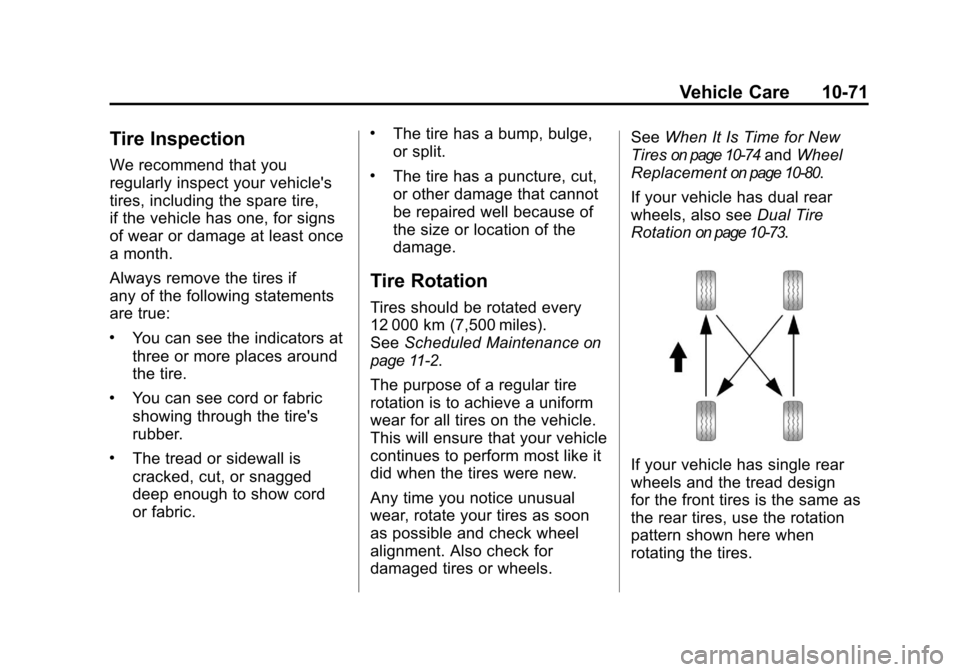
Black plate (71,1)Chevrolet Silverado Owner Manual - 2011
Vehicle Care 10-71
Tire Inspection
We recommend that you
regularly inspect your vehicle's
tires, including the spare tire,
if the vehicle has one, for signs
of wear or damage at least once
a month.
Always remove the tires if
any of the following statements
are true:
.You can see the indicators at
three or more places around
the tire.
.You can see cord or fabric
showing through the tire's
rubber.
.The tread or sidewall is
cracked, cut, or snagged
deep enough to show cord
or fabric.
.The tire has a bump, bulge,
or split.
.The tire has a puncture, cut,
or other damage that cannot
be repaired well because of
the size or location of the
damage.
Tire Rotation
Tires should be rotated every
12 000 km (7,500 miles).
SeeScheduled Maintenance
on
page 11‑2
.
The purpose of a regular tire
rotation is to achieve a uniform
wear for all tires on the vehicle.
This will ensure that your vehicle
continues to perform most like it
did when the tires were new.
Any time you notice unusual
wear, rotate your tires as soon
as possible and check wheel
alignment. Also check for
damaged tires or wheels. See
When It Is Time for New
Tires
on page 10‑74and Wheel
Replacement
on page 10‑80.
If your vehicle has dual rear
wheels, also see Dual Tire
Rotation
on page 10‑73.
If your vehicle has single rear
wheels and the tread design
for the front tires is the same as
the rear tires, use the rotation
pattern shown here when
rotating the tires.
Page 498 of 588

Black plate (76,1)Chevrolet Silverado Owner Manual - 2011
10-76 Vehicle Care
Replacing less than a full set of
tires can affect the braking and
handling performance of your
vehicle. SeeTire Inspection
on
page 10‑71and Tire Rotationon
page 10‑71for information on
proper tire rotation.
{WARNING
Tires could explode during
improper service. You or others
could be injured or killed if you
attempt to mount or dismount
a tire. Only your dealer or an
authorized tire service center
should mount and dismount
the tires.
{WARNING
Mixing tires could cause you
to lose control while driving.
If you mix tires of different sizes,
(Continued)
WARNING (Continued)
brands, or types (radial and
bias-belted tires), the vehicle
might not handle properly, and
you could have a crash. Using
tires of different sizes, brands,
or types could also cause
damage to your vehicle. Be sure
to use the same size, brand, and
type of tires on all wheels.
Your vehicle may have a different
size spare than the road tires
(those originally installed on your
vehicle). When new, your vehicle
included a spare tire and wheel
assembly with a similar overall
diameter as your vehicle's road
tires and wheels, so it is all right
to drive on it. Because this spare
was developed for use on your
vehicle, it will not affect vehicle
handling.
{WARNING
If you use bias-ply tires on
the vehicle, the wheel rim
flanges could develop cracks
after many miles of driving.
A tire and/or wheel could fail
suddenly, causing a crash.
Use only radial-ply tires with
the wheels on the vehicle.
If you must replace your vehicle's
tires with those that do not have
a TPC Spec number, make sure
they are the same size, load range,
speed rating, and construction type
(radial and bias‐belted tires) as your
vehicle's original tires.
Page 499 of 588
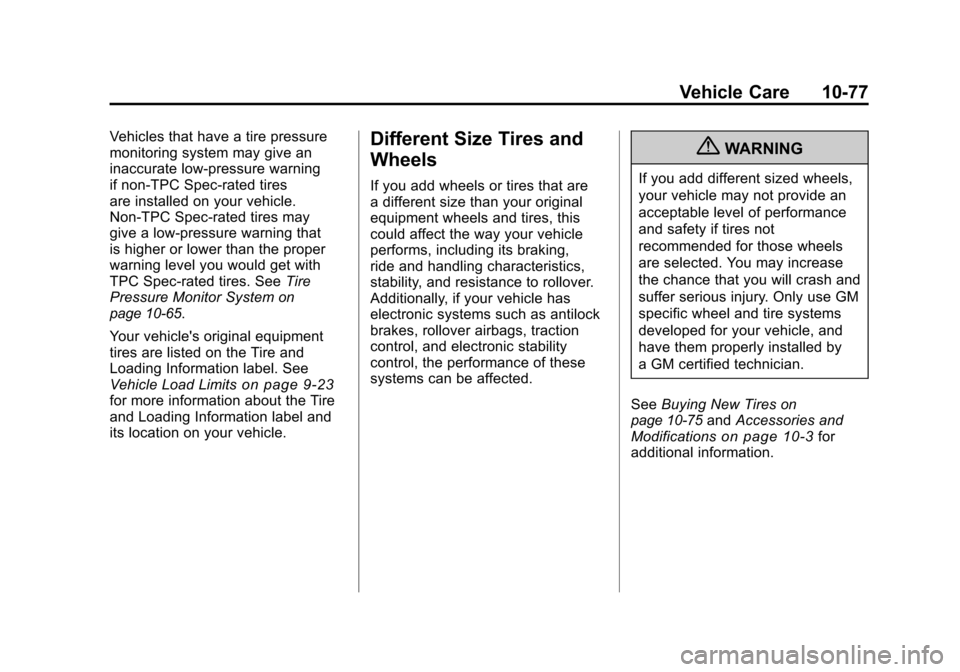
Black plate (77,1)Chevrolet Silverado Owner Manual - 2011
Vehicle Care 10-77
Vehicles that have a tire pressure
monitoring system may give an
inaccurate low‐pressure warning
if non‐TPC Spec-rated tires
are installed on your vehicle.
Non‐TPC Spec-rated tires may
give a low‐pressure warning that
is higher or lower than the proper
warning level you would get with
TPC Spec-rated tires. SeeTire
Pressure Monitor System
on
page 10‑65.
Your vehicle's original equipment
tires are listed on the Tire and
Loading Information label. See
Vehicle Load Limits
on page 9‑23for more information about the Tire
and Loading Information label and
its location on your vehicle.
Different Size Tires and
Wheels
If you add wheels or tires that are
a different size than your original
equipment wheels and tires, this
could affect the way your vehicle
performs, including its braking,
ride and handling characteristics,
stability, and resistance to rollover.
Additionally, if your vehicle has
electronic systems such as antilock
brakes, rollover airbags, traction
control, and electronic stability
control, the performance of these
systems can be affected.
{WARNING
If you add different sized wheels,
your vehicle may not provide an
acceptable level of performance
and safety if tires not
recommended for those wheels
are selected. You may increase
the chance that you will crash and
suffer serious injury. Only use GM
specific wheel and tire systems
developed for your vehicle, and
have them properly installed by
a GM certified technician.
See Buying New Tires
on
page 10‑75and Accessories and
Modificationson page 10‑3for
additional information.
Page 503 of 588
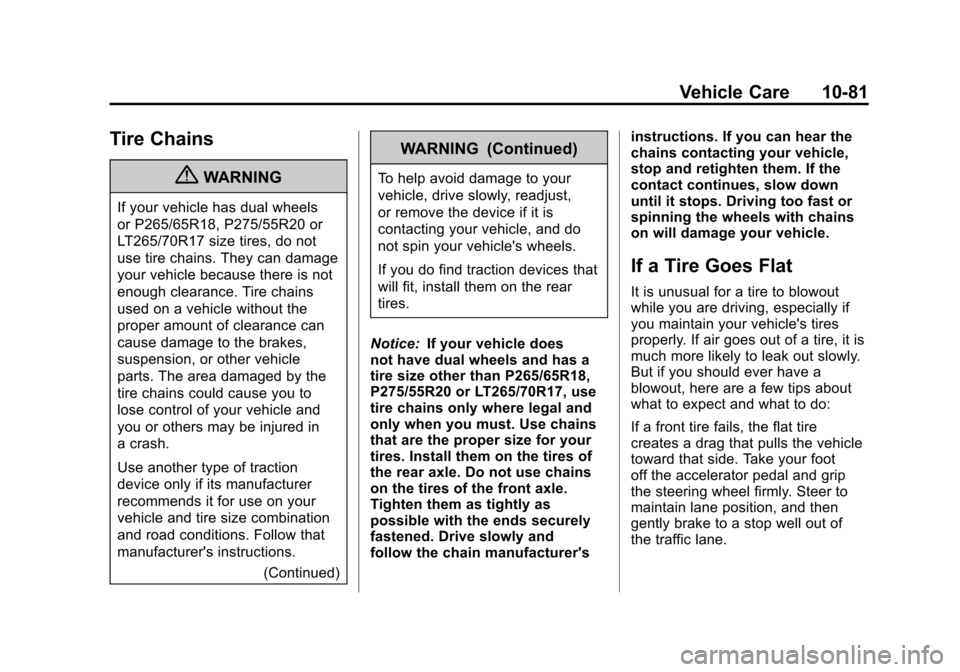
Black plate (81,1)Chevrolet Silverado Owner Manual - 2011
Vehicle Care 10-81
Tire Chains
{WARNING
If your vehicle has dual wheels
or P265/65R18, P275/55R20 or
LT265/70R17 size tires, do not
use tire chains. They can damage
your vehicle because there is not
enough clearance. Tire chains
used on a vehicle without the
proper amount of clearance can
cause damage to the brakes,
suspension, or other vehicle
parts. The area damaged by the
tire chains could cause you to
lose control of your vehicle and
you or others may be injured in
a crash.
Use another type of traction
device only if its manufacturer
recommends it for use on your
vehicle and tire size combination
and road conditions. Follow that
manufacturer's instructions.(Continued)
WARNING (Continued)
To help avoid damage to your
vehicle, drive slowly, readjust,
or remove the device if it is
contacting your vehicle, and do
not spin your vehicle's wheels.
If you do find traction devices that
will fit, install them on the rear
tires.
Notice: If your vehicle does
not have dual wheels and has a
tire size other than P265/65R18,
P275/55R20 or LT265/70R17, use
tire chains only where legal and
only when you must. Use chains
that are the proper size for your
tires. Install them on the tires of
the rear axle. Do not use chains
on the tires of the front axle.
Tighten them as tightly as
possible with the ends securely
fastened. Drive slowly and
follow the chain manufacturer's instructions. If you can hear the
chains contacting your vehicle,
stop and retighten them. If the
contact continues, slow down
until it stops. Driving too fast or
spinning the wheels with chains
on will damage your vehicle.
If a Tire Goes Flat
It is unusual for a tire to blowout
while you are driving, especially if
you maintain your vehicle's tires
properly. If air goes out of a tire, it is
much more likely to leak out slowly.
But if you should ever have a
blowout, here are a few tips about
what to expect and what to do:
If a front tire fails, the flat tire
creates a drag that pulls the vehicle
toward that side. Take your foot
off the accelerator pedal and grip
the steering wheel firmly. Steer to
maintain lane position, and then
gently brake to a stop well out of
the traffic lane.